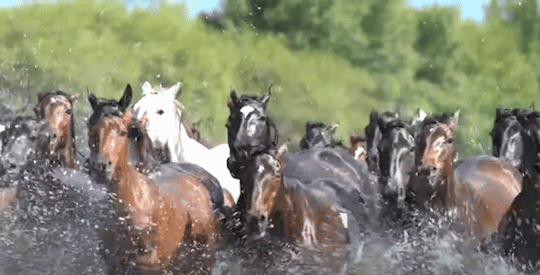#river mammals
Photo



The Beautiful Boto
Also known as the Amazon river dophin or the pink river dolphin, the boto (Inia geoffrensis) is a species of toothed whale native to the Amazon and Orinoco river basins in South America. Because they reside mainly in rivers, lakes and mangroves, the boto occupies a large range; nearly 7 million square kilometers (435 thousand square miles). Despite being related to whales and dolphins, I. geoffrensis cannot tolerate saltwater and is only found in freshwater.
The Amazon river dolphin is the largest of the four river dolphin species, weighing in at 98-185 kg (215-407 lbs) and measuring 1 to 2.5 m (4-8 ft) in length. Males are larger than females, and are a bright pink to the females’ dull grey. A significant part of the length comes from the dolphin’s distinctive long snout, which is used to hunt for crustaceans and small fish. The boto’s body is designed to be highly flexible, which comes in handy when navigating through flooded forests. One adaptation in particular that makes I. geoffrensis stand out is the unfused neck vertebrae, which allows them to bend at up to a 90-degree angle. Botos also use echolocation to navigate murky river waters. which is enhanced by the large melon on their foreheads.
Breeding for the pink river dophin occurs between May and June, during the rainy season when flooding is at its peak. Males will fight for access to females, and will also perform courtship displays that involve carrying a number of objects-- like branches, fish, or even live turtles-- and slapping them into the water. Successful pregnancies last 11 months, and after giving birth mothers raise their young in the slow-moving waters of flooded forests. Weaning takes about a year, although mother-child pairs will often stay together for much longer. The average lifespan of the boto can be anywhere from 10 to 26 years, as they have no natural predators.
Outside the mating season, I. geoffrensis is a solitary creature. It’s rare to see groups of more than three at a time, and do not heavily defend set territories. However, they are very curious and have been known to readily approach canoes or play with debris in the water. Individuals have also been seen hunting fish in loose cooperation with other species like giant river otters (Pteronura brasiliensis). The bota is crepuscular, active mainly at dawn or dusk, and generally stay close to the surface of the water. Deep dives are rare, as they can only hold their breath for 110 seconds.
Conservation status: Hunting pressure and pollution, as well as dam building and deforestation, are major threats to the amazon river dolphin, which has been classified as Endangered by the IUCN. Conservation efforts are being made, but the species is difficult to keep or breed in captivity so most work is being done in the wild.
If you like what I do, consider leaving a tip or buying me a kofi!
Photos
Sylvain Cordier
Kevin Schafer
#amazon river dolphin#boto#cetacea#Iniidae#river dolphins#dolphins#toothed whales#mammals#rivers#river mammals#wetlands#wetland mammals#tropical rainforests#tropical rainforest mammals#freshwater fauna#freshwater mammals#south america#central south america#Amazon Rainforest#animal facts#biology#zoology
477 notes
·
View notes
Text

Long Water Doggos (Ambulocetids)
Patreon • Ko-fi • Facebook • Twitter • Prints & Merch
3K notes
·
View notes
Text

Trapping and Conservation Manual: 3rd edition. 1985. Alberta Energy and Natural Resources: Fish and Wildlife Division.
Internet Archive
458 notes
·
View notes
Text
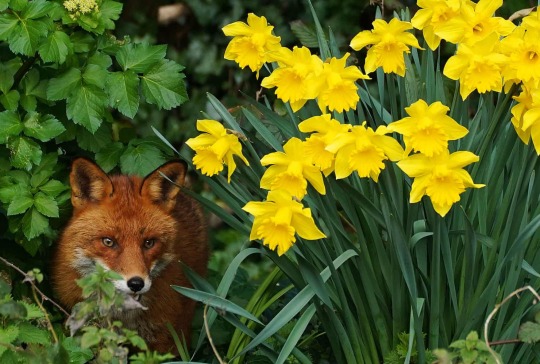
A fox among blooming daffodils on the banks of the Dodder River in Dublin, Ireland
Photograph: Brian Lawless/PA
#brian lawless#photographer#pa#fox#animal#mammal#wildlife#daffodils#river bank#dodder river#dublin#ireland#nature
280 notes
·
View notes
Text

#horses#horse#animals#mustangs#science#education#nature#photography#animal#landsccape#cute animals#funny#lol#adorable#landscape#paradise#explore#gifs#beautiful#beauty#primates#zoos#mammals#wild animals#wildlife#mountain#incredible#running#wetland#river
55 notes
·
View notes
Text
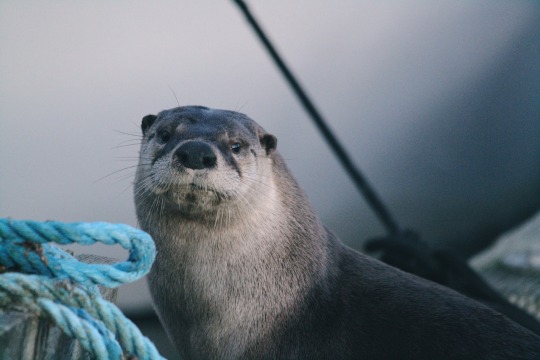
River otter at fisherman’s wharf
#river otter#marine mammals#original photography#lensblr#original photography on tumblr#nature#vancouver island#nature photography#pnw#ocean
63 notes
·
View notes
Text
in the latest episode of the Smithsonian Sidedoor podcast, the host goes to great lengths to describe how elusive and hard to spot river otters are, meanwhile I've seen them in a city park?? during broad daylight??? in a major metro area???? many times????? She even interviews an otter researcher who is like 'I've been studying them for years and still only actually seen one in person at the national zoo :('
like girl, move to seattle maybe? idk what to tell you, I've seen them while walking my dog or birding or even just getting coffee.
#????? do they live in an alternate reality where otters are not supremely unconcerned with human nonsense?#river otters in seattle harbor are like. less common than harbor seals but more common than sea lions or porpoises.#maybe just above orca-level common and more usual right in shore#solidly mid-tier level 'oh look! there goes a marine* mammal!'#*yes I know. they're called 'river' otters. they do happily venture into salt water though. they don't care what we named them lmao.
88 notes
·
View notes
Text

North American river otter
By: Unknown photographer
From: WWF Threatened Animals
1986
84 notes
·
View notes
Text
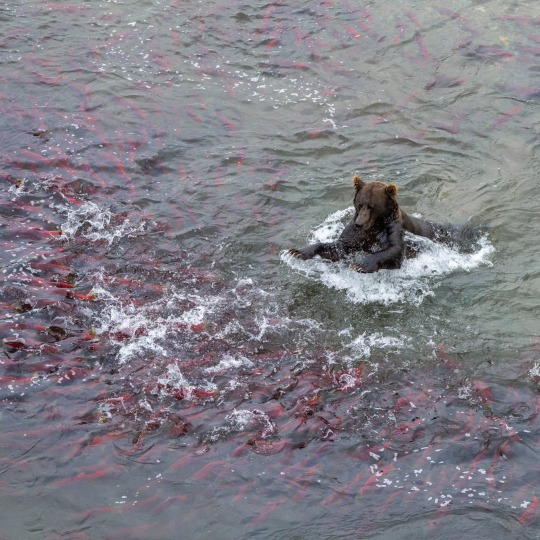
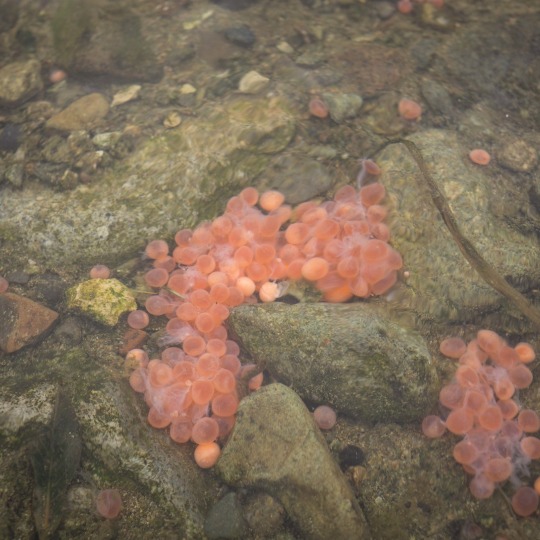
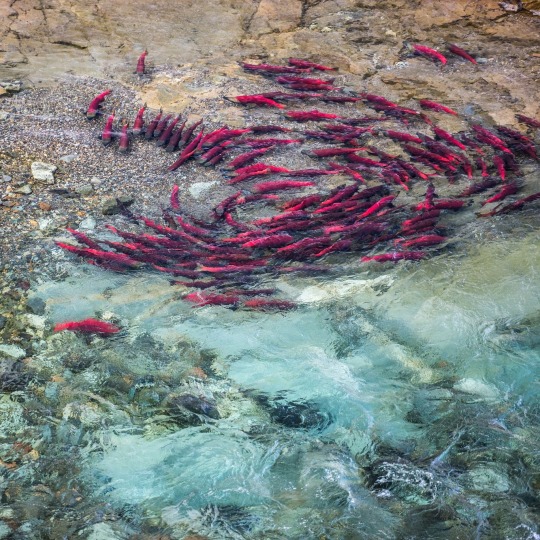
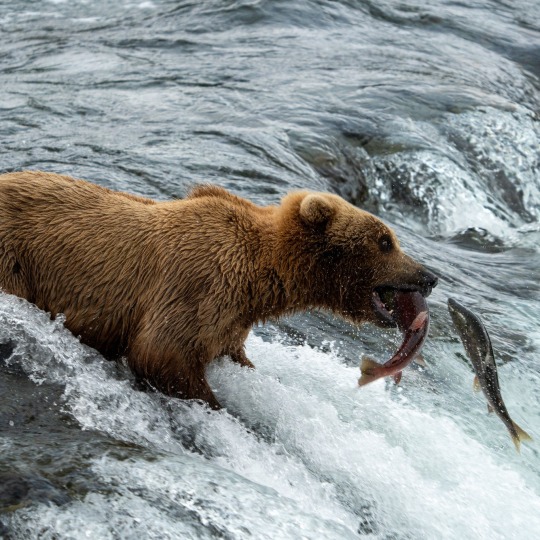
Salmon Run in Alaska
At Katmai National Park & Preserve in Alaska, salmon are the lifeblood of a fertile coastal ecosystem. At Brooks Falls, the salmon must run a gauntlet of hungry bears, wolves, birds and other fish-eaters before spawning further inland.
Every summer, sockeye salmon return from the ocean, where they have spent two or three years, and travel up rivers, lakes and streams to return to the headwater gravel beds of their birth to deposit their young before dying.
A sockeye salmon fresh from the sea in July contains around 4,500 calories, while a spawned-out salmon in September may only have half that many.
Bears feast on them and turn into the chonky celebrities of #FatBearWeek!
The last few documented salmon runs have shown high numbers — in 2019, they reached a record-breaking 62.3 million, and in 2021, they broke that record again with almost 65 million sockeye. The 2022 salmon run was strong and healthy, with approximately 50 million sockeye.
Right now, there are enough salmon to go around, but scientists continue to monitor and collect data to understand what kind of impacts heat and weather patterns will have on future runs.
Learn more about sockeye salmon in Katmai.
Photographs by F. Jimenez, Russ Taylor, Anela Ramos and Lian Law / NPS
via: U.S. Department of the Interior
#fish#salmon#salmonid#fisheries#ocean#rivers#alaska#bear#bears#brown bear#mammal#animals#nature#north america#ecology#science
109 notes
·
View notes
Text
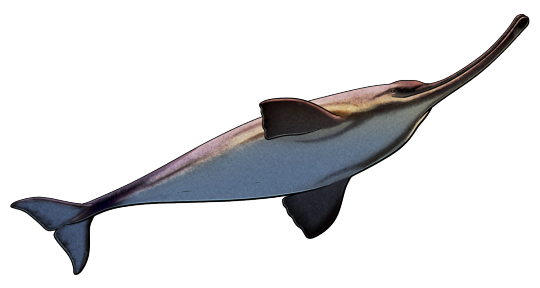
Strange Symmetries #19: Wonky Whales
Toothed whales – the branch of cetaceans that includes modern dolphins, porpoises, beaked whales, and sperm whales – have surprisingly asymmetrical skulls, with some of the bones skewed to one side and just the left nostril forming their blowhole.
Some of the most obvious external manifestation of this lopsidedness can be seen in sperm whales, which have their blowhole at the front left side of their head, and in male narwhals, which usually have a single left-side tusk.
This sort of asymmetry first appeared in the skulls of early toothed whales around 30 million years ago. And since the highest amounts of wonkiness have gone on to develop in lineages that hunt in dark, cluttered, or murky waters, this suggests that the trait is somehow linked to the evolution of complex echolocation.
Some ancient members of the river dolphin lineage also had some additional unusual asymmetry, sometimes having slightly sideways-bending snouts.
Ensidelphis riveroi was one of the weirdest of these, living around the coasts of what is now Peru during the Miocene, about 19 million years ago. Around 3m long (~10'), it had a very long narrow toothy snout that curved distinctly off to the right along its length.
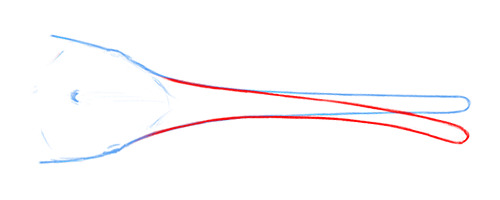
It's not clear what the function of this bend was, or even if the only known skull actually represents the normal condition for this species. But Ensidelphis' bendy snoot might have been used to probe around in muddy seafloor sediment or to extract prey from crevices, possibly like an underwater version of the modern wrybill.
———
NixIllustration.com | Tumblr | Twitter | Patreon
#science illustration#strange symmetries#paleontology#paleoart#palaeoblr#ensidelphis#platanistoidea#river dolphin#odontoceti#toothed whale#cetacean#whale#artiodactyla#ungulate#mammal#marine mammal#art#side-snouted dolphin#it's weird dolphin hours#fat torpedoes who scream to navigate
350 notes
·
View notes
Text
Animal of the Day!
North American River Otter (Lontra canadensis)
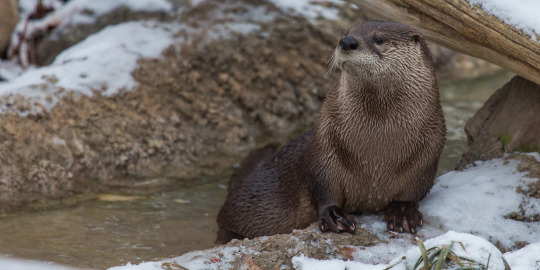
(Photo from Smithsonian National Zoo)
Conservation Status- Least Concern
Habitat- Northern North America; Eastern North America
Size (Weight/Length)- 12 kg; 1 m
Diet- Fish; Insects; Crayfish; Amphibians; Birds; Small mammals
Cool Facts- Despite having possibly the cutest face in the animal kingdom, don’t let their looks fool you. North American river otters are fantastic predators. Living in small family groups, these otters eat practically any animal they can get their claws on. During sunny days, North American river otters sunbathe on rocks and groom each other for hours to keep their fur waterproof. Pregnant females seek out empty beaver dens to have their babies, often given support by the rest of their family, usually sisters. At two months old, mothers teach their pups how to swim and hunt. Despite almost going extinct in the 1900s due to the fur trade, today North American river otters flourish thanks to reintroduction efforts and bans on hunting.
Rating- 13/10 (A little smelly but adorable regardless.)
#Animal of the day#Animals#Mammals#Otters#Saturday#January 21#North American river otter#biology#science#conservation#the more you know
231 notes
·
View notes
Text

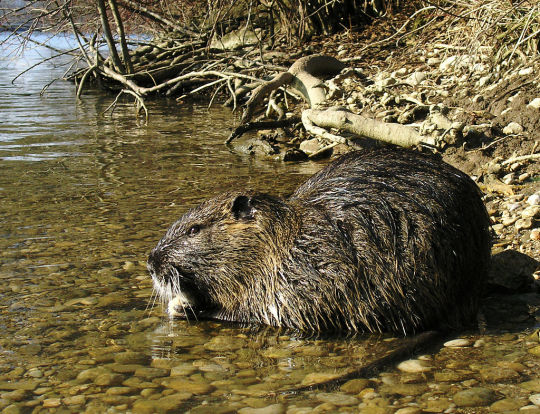
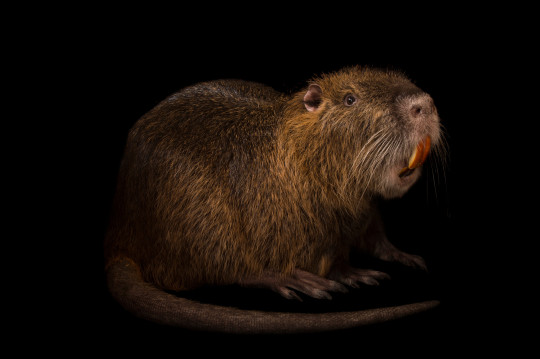
Noticing the Nutria
The nutria, or coypu (Myocastor coypus) is a species of rodent native to the lakes and wetlands of South America, from Bolivia to Tierra del Fuego in Chile and Argentina. It is often confused with capybara or beavers due to its size and shape; adults are typically 4-9 kg (9-20 lbs) and 40-60 cm (16-24 in) long. The fur is brown, and like its look-alikes the coypu has four large incisors that are a distinct orange color, which comes from the high amounts of iron in the enamel. M. coypus can be distinguished from other large rodents by its tail, which is long and slender-- ideal for swimming.
In addition to its thick three layers of fur, the nutria has several adaptations for a semi-aquatic life. Four of the five digits on the hind feet are webbed, and they have strong lungs that allow individuals to remain submerged for up to ten minutes. Females have nipples high on their flanks, to allow their young to suckle while they float in the water. The coypu's large teeth are used to feat on aquatic plants, as well as small animals like snails and mussels. Both the teeth and the tail are also used to deal with predators; when evading birds of prey, alligators, garfish, and other mammals the nutria will try to swim away, while the teeth can be used to deter turtles, snakes, and smaller predator fish.
In their native habitat, survival rates for M. coypus are extremely low. 80% of nutrias die within their first year, and it's rare for individuals to exceed three years of age in the wild. Males reach sexual maturity at 4 months old, while females can become sexually mature at only 3 months. Nutria are highly social, and can live in groups of 2-13 individuals, usually a large male and several mates and their litters. These groups construct platforms out of vegetation and burrows in muddy river banks- reaching up to 15 m (50 ft)-- where they mate and raise their young.
Mating occurs year-round, and it's not uncommon for a female to have 2 or 3 litters in a year. Gestation of a litter lasts about 130 days, after which she gives birth to an average of 5-7 young, though it may be as many as 14. Baby coypu are born with their eyes open, and can swim and feed on vegetation only hours after birth. These pups only remain with her for 4-8 weeks, after which they are weaned and either join the group as adults or leave to find another colony. This allows their mother to prepare herself for another litter-- an important task, as she is ready to become pregnant again the day after giving birth.
Conservation status: The IUCN has yet to rate the nutria, although studies have suggested they're disappearing from their native rivers and lakes. Conversely, M. coypus is highly invasive in parts of North America, Europe, Asia, and Africa, where it has been introduced by fur ranchers.
If you like what I do, consider leaving a tip or buying me a kofi!
Photos
Greg Lasley via iNaturalist
Petar Milošević via Wikipedia
Joel Sartore
#nutria#coypa#Rodentia#Echimyidae#spiny rats#rodents#mammals#wetlands#wetland mammals#lakes#lake mammals#rivers#river mammals#freshwater fauna#freshwater mammals#south america#southern south america#animal facts#biology#zoology
162 notes
·
View notes
Text

Lots of fresh beaver chews by the river today! 4/24/24
#beavers#animal tracking#nature#wildlife#beaver#mammals#mine#naturalist#nature photography#photography#ecology#north america#animals#original photography#original photographers#landscape photography#landscape#native land#river#rivers#ecologist#biologist#natural history#environmental education#forest#trees
20 notes
·
View notes
Text
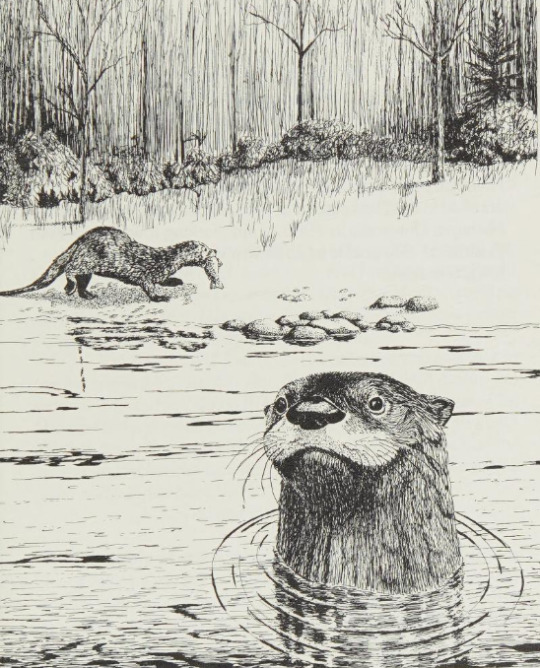
Getting to Know Our Wildlife. Written by Betty Sodders. Illustrated by art students at Northern Michigan University. 1991.
Internet Archive
476 notes
·
View notes
Text

A river otter in Florida.
© Mark Conlin
55 notes
·
View notes
